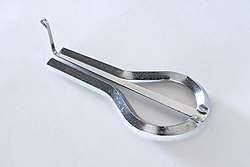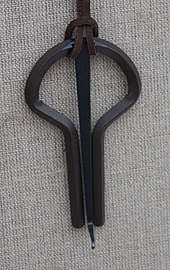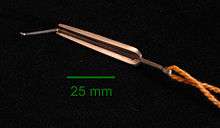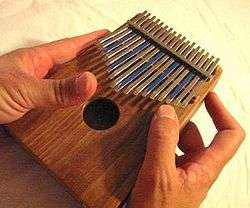Jew's harp
The Jew's harp, also known as the jaw harp, mouth harp, gewgaw, guimbard, khomus, trump, Ozark harp, Galician harp, or murchunga is a lamellophone instrument, consisting of a flexible metal or bamboo tongue or reed attached to a frame.
 Jew's harp found in the US (c. 1860s)[1] | |
| Percussion instrument | |
|---|---|
| Other names | jaw harp, mouth harp, Ozark harp, juice harp, murchunga, guimbarde |
| Classification | |
| Hornbostel–Sachs classification | 121.22 (Heteroglot guimbarde (the lamella is attached to the frame)) |
| Related instruments | |

Jew's harps may be categorized as idioglot or heteroglot (whether or not the frame and the tine are one piece), by the shape of the frame (rod or plaque), by the number of tines, and whether the tines are plucked, joint-tapped, or string-pulled.[2]
Characteristics
The frame is held firmly against the performer's parted teeth or lips (depending on the type), using the jaw and mouth as a resonator, greatly increasing the volume of the instrument. The teeth must be parted sufficiently for the reed to vibrate freely, and the fleshy parts of the mouth should not come into contact with the reed to prevent damping of the vibrations and possible pain. The note or tone thus produced is constant in pitch, though by changing the shape of the mouth, and the amount of air contained in it (and in some traditions closing the glottis), the performer can cause different overtones to sound and thus create melodies.
According to the Encyclopædia Britannica Eleventh Edition, "The vibrations of the steel tongue produce a compound sound composed of a fundamental and its harmonics. By using the cavity of the mouth as a resonator, each harmonic in succession can be isolated and reinforced, giving the instrument the compass shown."

"The lower harmonics of the series cannot be obtained, owing to the limited capacity of the resonating cavity. The black notes on the stave show the scale which may be produced by using two harps, one tuned a fourth above the other. The player on the Jew's harp, in order to isolate the harmonics, frames his mouth as though intending to pronounce the various vowels."[3] See: bugle scale.
History

The earliest depiction of somebody playing what seems to be a Jew's harp is a Chinese drawing from the 3rd Century BC, and curved bones discovered in the Shimao fortifications in Shaanxi, China are believed to be the earliest evidence of the instrument, dating back to before 1800 B.C.E. [4][5] Archaeological finds of surviving examples in Europe have been claimed to be almost as old, but those dates have been challenged both on the grounds of excavation techniques, and the lack of contemporary writing or pictures mentioning the instrument.[6]
Although this instrument is used by lackeys and people of the lower class, this does not mean it is not worthy of consideration by better minds ... The trump is grasped while its extremity is placed between the teeth in order to play it and make it sound ... Now one may strike the tongue with the index finger in two ways, i.e., by lifting it or lowering it: but it is easier to strike it by raising it, which is why the extremity, C, is slightly curved, so that the finger is not injured ... Many people play this instrument. When the tongue is made to vibrate, a buzzing is heard which imitates that of bees, wasps, and flies ... [if one uses] several Jew's harps of various sizes, a curious harmony is produced.
Etymology
There are many theories for the origin of the name Jew's harp. According to the Oxford English Dictionary, this name appears earliest in Walter Raleigh's Discouerie Guiana in 1596, spelled "Iewes Harp". The "jaw" variant is attested at least as early as 1774[8] and 1809,[9] the "juice" variant appeared only in the late 19th and 20th centuries.
It has also been suggested that the name derives from the French "Jeu-trompe" meaning "toy-trumpet".[10] (Though in the French idiom, if two substantives are joined together, the qualifying noun is invariably the last.)[11]
Both theories—that the name is a corruption of "jaws" or "jeu"—are described by the OED as "baseless and inept". The OED says that, "More or less satisfactory reasons may be conjectured: e.g. that the instrument was actually made, sold, or imported to England by Jews, or purported to be so; or that it was attributed to Jewish people, suggesting the trumps and harps mentioned in the Bible, and hence considered a good commercial name."[12]
Use


Cambodian music
The angkouch (Khmer: អង្គួច) is a Cambodian jew's harp.[13] It is a folk instrument made of bamboo and carved into a long, flat shape with a hole in the center and the tongue across the hole.[14] There is also a metal variety, more round or tree-leaf shaped.[14] It may also have metal bells attached.[14] The instrument is both a wind instrument and percussion instrument.[13][14] As a wind instrument, it is placed against the mouth, which acts as a resonator and tool to alter the sound.[14] Although mainly a folk instrument, better-made examples exist.[14] While the instrument was thought to be the invention of children herding cattle, it is sometimes used in public performance, to accompany the Mahori music in public dancing.[14]
Carnatic music
The instrument, known as morsing in South India,[15] morchang in Rajasthan, or murchunga in Nepal (where they are common), is part of the rhythmic section in a Carnatic music ensemble.
Turkic traditional music
Sindhi music
In Sindhi the Jew's harp is called Changu (چنگُ). In Sindhi music, it can be an accompaniment or the main instrument. One of the most famous players is Amir Bux Ruunjho.[16]
World music
The Jew's harp is frequently to be found in the repertoire of music played by alternative or world music bands.
Austrian Jew's harp playing
Austrian Jew's harp music uses typical Western harmony. The UNESCO has included Austrian Jew's harp playing in its Intangible Cultural Heritage list.[17]
Western classical music
Early representations of Jew's harps appeared in Western churches since the fourteenth century.[18]
The Austrian composer Johann Albrechtsberger—chiefly known today as a teacher of Beethoven—wrote seven concerti for Jew's harp, mandora, and orchestra between 1769 and 1771. Four of them have survived, in the keys of F major, E-flat major, E major, and D major.[19] They are based on the special use of the Jew's harp in Austrian folk music.
In the experimental period at the end of the 18th and beginning of the 19th century there were very virtuoso instrumentalists on the mouth harp. Thus, for example, Johann Heinrich Scheibler was able to mount up to ten mouth harps on a support disc. He called the instrument "Aura". Each mouth harp was tuned to different basic tones, which made even chromatic sequences possible.
— Walter Maurer, translated from German[20]
Well known performer Franz Koch (1761–1831), discovered by Frederick the Great, could play two Jew's harps at once, while the also well known performer Karl Eulenstein (1802—1890), "invented a system of playing four at once, connecting them by silken strings in such a way that he could clasp all four with the lips, and strike all the four springs at the same time".[21]
The American composer Charles Ives wrote a part for Jew's harp in the Washington's Birthday movement of A Symphony: New England Holidays.[22]
Western rock music
It features prominently in Canned Heat's multi-part piece "Parthenogenesis" from their Living the Blues album.[23][24]
It appears prominently in the Red Hot Chili Pepper's song "Give It Away" from their album Blood Sugar Sex Magik.
The Jew's harp provides a distinctive sound for the beginning of The Who's "Join Together".[25]
It appears in Johnny Cash's recording of "God's Gonna Cut You Down" from his album American V: A Hundred Highways.[26]
Kyrgyz music
The temir komuz is made of iron usually with a length of 100–200 mm and with a width of approximately 2–7 mm. The range of the instrument varies with the size of the instrument, but generally hovers around an octave span. The Kyrgyz people are exceptionally proficient on the temir komuz instrument and it is quite popular among children, although some adults continue to play the instrument. There is a National Artist of Kyrgyz Republic who performs on the instrument, temir komuz. One time twenty Kirgiz girls played in a temir komuz ensemble on the stage of the Bolshoi Theater in Moscow. Temir komuz pieces were notated by Zataevich in two or three parts. Apparently an octave drone is possible, or even an ostinato alternating the fifth step of a scale with an octave.[27]

See also
- Jew's harp music
- Đàn môi, another kind of Jew's harp from Vietnam
- Gogona, a similar instrument played by Assamese people (especially women) while singing and dancing Bihu
- Kouxian, the Chinese version
- Kubing, a bamboo Jew's harp from the Philippines
- Morsing, Carnatic Jew's harp
- Mukkuri, a traditional bamboo instrument of the Ainu of Japan, similar to a Jew's harp.
- Music of Central Asia
- Traditional music of Sicily
- Musical bow, a one-string harp that is played with mouth resonance.
- Piperheugh, a village in which trumps were once made.
- Karinding, a Sundanese traditional musical instrument from West Java and Banten, Indonesia.
References
Notes
- "Gettysburg: Civil War Collections: Jaw Harp", NPS.gov.
- Wright, Michael (2004). "The Search for the Origins of the Jew’s Harp", SilkRoadFoundation.org.
- Schlesinger 1911.
- "Sicilian Item of the day:Marranzano". Siciliamo (blog). 2007-08-10. Retrieved 2008-02-20.
- Larmer, Brook (2020). "Mysterious carvings and evidence of human sacrifice uncovered in ancient city". National Geographic.
- Silkroad Foundation; Lee, Adela C.Y. "The Search for the Origins of the Jee's Harp". silkroadfoundation.org. Retrieved 20 June 2015.
- Fox (1988), p.45-8.
- Muiscellaneous and Fugitive pieces, vol3, Johnson et al. 1774
- Pegge's Anonymiana, 1818, p 33
- Timbs, John (1858). Things Not Generally Known: Popular Errors Explained & Illustrated. p. 61.
- Wedgwood, Hensleigh (1855). "On False Etymologies". Transactions of the Philological Society (6): 63.
- "Jews' trump, Jew's-trump". Oxford English Dictionary. Oxford University Press. 1989.
- Poss, M.D. "Cambodian Bamboo Jew's Harps". mouthmusic.com. Retrieved 27 October 2018.
... these bamboo Jew's harps are easy to hold and may be longer lasting due to being made of thicker material than many other similar instruments. Held against the lips, they are easy to play and offer the same full, percussive sound as the "Kubings."
- Khean, Yun; Dorivan, Keo; Lina, Y; Lenna, Mao. Traditional Musical Instruments of Cambodia (PDF). Kingdom of Cambodia: United Nations Educational, Scientific and Cultural Organization. pp. 146–147.
- (1999). South Asia : The Indian Subcontinent. Garland Encyclopedia of World Music, Volume 5. Publisher: Routledge; Har/Com. ISBN 978-0-8240-4946-1.
- sindhi alghozo. YouTube. 9 July 2009. Retrieved 20 June 2015.
- Intangible Cultural Heritage in Austria: Jew's Harp Playing in Austria (archived version at the Internet Archive from October 3, 2015)
- For example, there is a carving of a centaur playing a Jew's harp in the Basel Münster. Musiconis Database. Université Paris-Sorbonne. http://musiconis.huma-num.fr/fiche/120/Hybride+jouant+de+la+guimbarde. Accessed January 5, 2018.
- Albrechtsberger: Concerto for Jew's Harp, Amazon CD Listing (Munich Chamber Orchestra, December 19, 1992, for more see: http://www.fondationlaborie.com/images/stories/notesdeprogramme/lc08_en.pdf)
- Maurer, Walter (1983). Accordion: Handbuch eines Instruments, seiner historischen Entwicklung un seiner Literature, p.19. Vienna: Edition Harmonia.
- Burnley, James (1886). The Romance of Invention: Vignettes from the Annals of Industry and Science, p.335. Cassell. [ISBN unspecified].
- Fox, Leonard (1988). The Jew's Harp: A Comprehensive Anthology. Associated University Presses, Inc. p. 33. ISBN 9780838751169. Retrieved 12 May 2015.
- Graves, Tom (30 April 2015). Louise Brooks, Frank Zappa, & Other Charmers & Dreamers. BookBaby. p. 155. ISBN 978-1-942531-07-4. Retrieved 1 November 2018.
- Winters, Rebecca Davis (2007). Blind Owl Blues. Blind Owl Blues. p. 159. ISBN 978-0-615-14617-1. Retrieved 1 November 2018.
- The Who - Join Together. YouTube. 20 March 2010. Retrieved 16 September 2016.
- http://zeegrooves.blogspot.com/2013/09/johnny-cash-gods-gonna-cut-you-down.html
- Slobin, Mark (1969). Kirgiz Instrumental Music. Theodore Front Music. p. 20. ISBN 978-0-614-16459-6. Retrieved February 23, 2014.
Bibliography
- Alekseev, Ivan, and E. I. [i.e. Egor Innokent'evich] Okoneshnikov (1988). Iskusstvo igry na iakutskom khomuse. IAkutsk: Akademiia nauk SSSR, Sibirskoe otd-nie, IAkutskii filial, In-t iazyka, lit-ry i istorii.
- Bakx, Phons (1992). De gedachtenverdrijver: de historie van de mondharp. Hadewijch wereldmuziek. Antwerpen: Hadewijch; ISBN 90-5240-163-2.
- Boone, Hubert, and René de Maeyer (1986). De Mondtrom. Volksmuziekinstrumenten in Belgie en in Nederland. Brussel: La Renaissance du Livre.
- Crane, Frederick (1982). "Jew's (jaw's? jeu? jeugd? gewgaw? juice?) harp." In: Vierundzwanzigsteljahrschrift der Internationalen Maultrommelvirtuosengenossenschaft, vol. 1 (1982). With: "The Jew's Harp in Colonial America," by Brian L. Mihura.
- Crane, Frederick (2003). A History of the Trump in Pictures: Europe and America. A special supplement to Vierundzwanzigsteljahrsschrift der Internationalen Maultrommelvirtuosengenossenschaft. Mount Pleasant, Iowa: [Frederick Crane].
- Dournon-Taurelle, Geneviève, and John Wright (1978). Les Guimbardes du Musée de l'homme. Preface by Gilbert Rouget. Published by the Muséum national d'histoire naturelle and l'Institut d'ethnologie.
- Emsheimer, Ernst (1941). "Über das Vorkommen und die Anwendungsart der Maultrommel in Sibirien und Zentralasien". In: Ethnos (Stockholm), nos 3–4 (1941).
- Emsheimer, Ernst (1964). "Maultrommeln in Sibirien und Zentralasien." In: Studia ethnomusicologica eurasiatica (Stockholm: Musikhistoriska museet, pp. 13–27).
- Fox, Leonard (1984). The Jew's Harp: A Comprehensive Anthology. Selected, edited, and translated by Leonard Fox. Charleston, South Carolina: L. Fox.
- Fox, Leonard (1988). The Jew's Harp: A Comprehensive Anthology. Selected, edited, and translated by Leonard Fox. Lewisburg: Bucknell University Press; London: Associated University Presses; ISBN 0-8387-5116-4.
- Gallmann, Matthew S. (1977). The Jews Harp: A Select List of References With Library of Congress Call Numbers. Washington, D.C.: Library of Congress, Archive of Folk Song.
- Gotovtsev, Innokenty. New Technologies for Yakut Khomus. Yakutsk.
- Kolltveit, Gjermund (2006). Jew's Harps in European Archaeology. BAR International series, 1500. Oxford: Archaeopress; ISBN 1-84171-931-5.
- Mercurio, Paolo (1998). Sa Trumba. Armomia tra telarzu e limbeddhu. Solinas Edition, Nuoro (IT).
- Plate, Regina (1992). Kulturgeschichte der Maultrommel. Orpheus-Schriftenreihe zu Grundfragen der Musik, Bd. 64. Bonn: Verlag für Systematische Musikwissenschaft; ISBN 3-922626-64-5.
- Schlesinger, Kathleen (1911). . In Chisholm, Hugh (ed.). Encyclopædia Britannica. 15 (11th ed.). Cambridge University Press. p. 411.CS1 maint: ref=harv (link)
- Shishigin, S. S. (1994). Igraite na khomuse. Mezhdunarodnyi tsentr khomusnoi (vargannoi) muzyki. Pokrovsk: S.S. Shishigin/Ministerstvo kul'tury Respubliki Sakha (IAkutiia). ISBN 5-85157-012-1.
- Shishigin, Spiridon. Kulakovsky and Khomus. Yakutia.
- Smeck, Roy (1974). Mel Bay's Fun With the Jaws Harp.
- Wright, Michael (2008). "The Jew's Harp in the Law, 1590–1825". In: Folk Music Journal 9.3 pp. 349–371; ISSN 0531-9684.
- Wright, Michael (2015). The Jew's Harp in Britain and Ireland. Farnham, Surrey: Ashgate; ISBN 978-1-4724-1413-7.
- Yuan, Bingchang, and Jizeng Mao (1986). Zhongguo Shao Shu Min Zu Yue Qi Zhi. Beijing: Xin Shi Jie Chu Ban She: Xin Hua Shu Dian Beijing Fa Xing Suo Fa Xing; ISBN 7-80005-017-3.
- Paolo Mercurio (2013). Gli Scacciapensieri Strumenti Musicali dell'Armonia Internazionali, Interculturali, Interdisciplinari. Milano; ISBN 978-88-6885-391-4.
External links
| Wikimedia Commons has media related to Jaw harps. |
- The Jew's Harp Guild
- How to play and make jew's harp
- How to play the jew's harp (instructions with sound examples and remarks on the functioning of Jew's harps)
- A page on guimbardes from Pat Missin's free reed instrument website
- Origins of the Jew's Harp. A popular synopsis of the archaeological findings of Jew's harps combined with an extensive illustrated survey of the world distribution of different types
- Demir-xomus (Tuvan Jew's Harp) Demos, photos, folktale, and text


